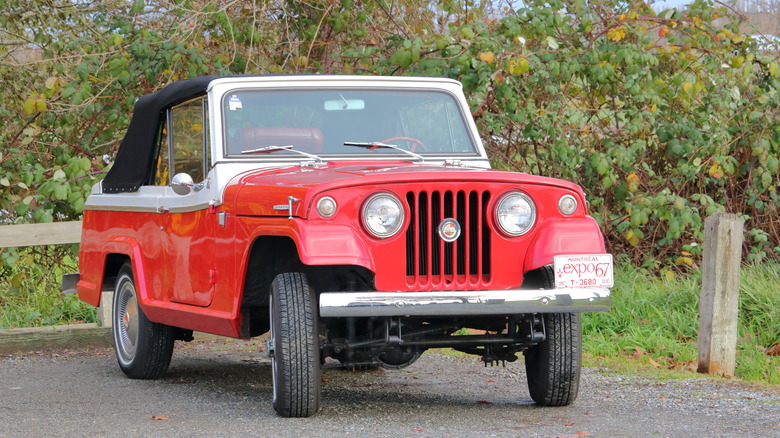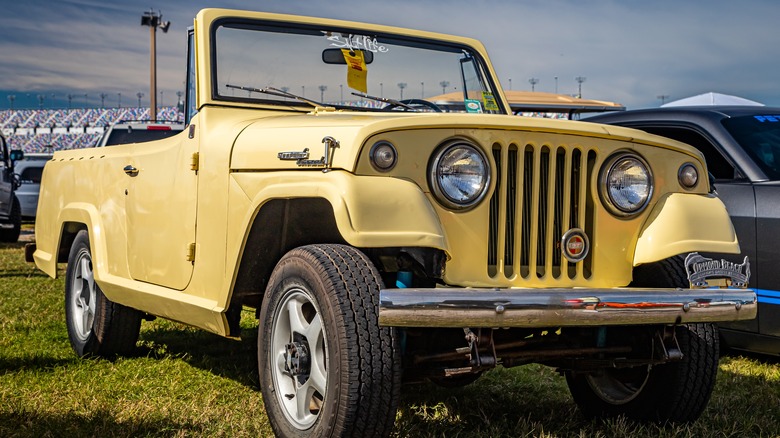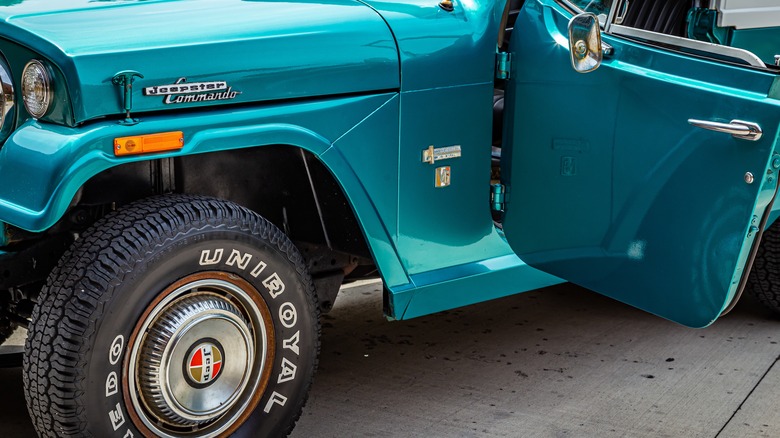Who Built The Jeepster Commando & What's One Worth Today?
It wouldn't be an exaggeration to say that most Jeeps have a familiar silhouette. The whole point of the brand is to make cars that wouldn't look out of place on either a casual jaunt to the beach or on an active battlefield, with stout, muscular bodies and rugged tires. However, we only know Jeeps to have this appearance now because the brand spent decades perfecting its aesthetic. In years past, Jeep didn't quite know what to do with itself, especially during some particularly turbulent times in the late '50s and early '60s.
Before the company was even known as just "Jeep," it was called Kaiser-Jeep, the result of a merger between a handful of smaller automotive brands looking to stay afloat in an extremely competitive automotive market. One of the first creations of this merged brand was an off-model vehicle that looked like a sporty sedan in the back and a traditional Jeep in the front. That vehicle was the Jeepster Commando, and its odd design sensibilities both make it interesting to look at and potentially rather valuable to the right buyer.
The Jeepster Commando was built by Kaiser-Jeep in the mid-1960s
In the mid-to-late 1950s, a pair of automotive companies, Willys-Overland and Kaiser-Frazer, underwent a merger, ultimately becoming the Kaiser-Jeep Corporation. If you're wondering why it's not something like "the Willys-Kaiser Corporation," that's because Jeeps were the only vehicles still being produced in the United States by Willys-Overland at the end of its solo run, so after Kaiser-Frazer bought it out, they picked a new name from the writing on the wall.
While Jeeps were the de facto rough-and-tumble four-wheel-drive car following the end of World War II, Kaiser-Jeep was getting muscled out of its turf by the likes of Dodge, International Harvester, and Ford. In an effort to compete, Kaiser-Jeep needed a mid-sizer, something with the 4WD it was known for, but with a more approachable body. As the company wasn't in the best place financially at the time, its mechanics had to raid the parts bin for hand-me-downs to put this new vehicle together.
The result of this was the Jeepster Commando, named after a similar car produced by Willys-Overland back in 1948. It was a Frankenstein vehicle — if you looked at it from the front, it was a Jeep, but if you looked at it from the back, it was a sedan. In a happy accident, this modular construction allowed Kaiser-Jeep to offer the Jeepster Commando in a wide variety of packages, including a roadster, a pickup, a convertible, and a station wagon.
The Jeepster Commando managed to get Kaiser-Jeep through its rough patch until its retirement in 1973, when the brand went whole-hog with beefier vehicles like the Cherokee.
Commandos typically sell between $20,000 and $30,000, but can go for more
While the current generation of Jeeps couldn't be any further from the Jeepster Commando's design sensibilities, that strange little car did pretty okay for itself in its time, selling a grand total of 77,573 units over the course of about six years. Obviously, that's a blip compared to the millions of Jeeps sold afterward, but it's nothing to sneeze at either. Thanks to its small, yet pivotal role in Jeep's greater history, not to mention its distinctive design, the Jeepster Commando has become a fairly respectable collector's item.
Based on auction sales from Bring a Trailer and Classic, the majority of Jeepster Commandos have sold for prices ranging from $20,000 to $30,000. Of course, the condition of the car and the package it's using play a large role in that pricing. On the bottom end of the pricing spectrum, an early Jeepster Commando with visible cosmetic damages like rust or dents may go for around $5,000. On the polar opposite side, a Jeepster Commando in pristine condition, particularly one with one of the limited-edition packages such as the 1971 Hurst Limited Edition model, can fetch as high as $85,000 at auction. As the later models in the Commando family had more features included, you may get a better price from the post-70s models than the late-60s ones.


